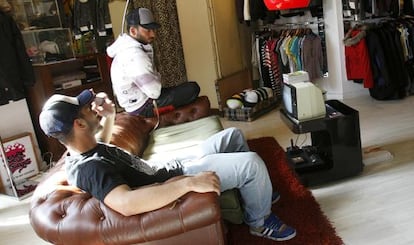Madrid’s landmark Mercado de Fuencarral to close in 2015
Alternative market helped revive rundown Chueca and Malasaña after it opened in 1998

Madrid’s Mercado de Fuencarral, the alternative shopping mall that helped jumpstart the regeneration of the now trendy Chueca and Malasaña neighborhoods when it opened in 1998, is closing down. And this time it looks like it’s for good.
“At the end of July 2015 we will say goodbye to this iconic place with a big party,” says Ramón Matoses, the building owner until just a few days ago.
Matoses says he has sold the property to an investment fund for a sum he declines to disclose, but which several internet sources put at around €22 million.
When the center opened on Fuencarral street 16 years ago, the surrounding area was run down and teeming with cars. When it shuts down next year, it will do so on one of the capital’s most popular thoroughfares, now completely pedestrianized and home to big-name brands such as Levi’s and Swarovski.
The owner has sold the site off to an investment fund for a sum internet sources put at around €22 million
“This is the spot where everything that was cool back then was going on,” recalls 33-year-old Zaida Rodríguez, who worked in the Mercado’s bar just after it opened. She spent four years steeped in the spirit of the Mercado, which was fashioned after London’s markets.
“It was the only place that was out of the ordinary: the best stores for clothes, music, piercings and tattoos were here in Mercado de Fuencarral. It was a little piece of London in the heart of Madrid, in a neighborhood full of junkies and prostitutes,” she says, referring to the area’s recent past.
“A multitude of cultural events were organized here: there were parties, concerts, and there was a DJ playing constantly upstairs,” remembers an employee at one of the stores in the three-floor center.
“On the one hand we saw it coming: this place isn’t what it used to be,” she says about the sale. “But it’s still a real bummer,” she adds, mulling the fact she will soon be out of a job.
This is where everything that was cool back then was going on”
Former Mercado employee Zaida Rodríguez
The GI Jane store, which is devoted to female military clothing, has been a part of the market since the beginning. “Since we set up here 16 years ago, there have been rumors that Zara was going to buy it,” jokes one of the store owners, Isabel Moreno, who says this is the second time she has had to deal with the threat of closure after similar news came to light in 2008.
Rumors of the sale started circulating on the internet on Monday morning. By that same afternoon, Moreno received a call from Matoses confirming the news. “I was in shock,” says Moreno, who is one of the few people in the mall willing to offer an opinion on the matter. In general, store owners don’t want to talk too much.
For Matoses, Mercado de Fuencarral worked because “it was in a very special part of Madrid; it was a bit rundown and needed some kind of action to change it.” And change it did. The neighborhood not only became home to bohemians and trendsetters, it also became one of the liveliest areas in the capital.
“The concept started to decline a bit, and things kind of went downhill, but they let it die,” say other store workers who declined to give their names. “This announcement illustrates Ramón Matoses’ bad management. He’s botched it again.”
Matoses says he does not know what the space will be converted to. “Rest assured that it pains me very much to close it,” he says. “I opened it. It’s my baby. I raised it and I fussed over it, but everything comes to an end.”
Tu suscripción se está usando en otro dispositivo
¿Quieres añadir otro usuario a tu suscripción?
Si continúas leyendo en este dispositivo, no se podrá leer en el otro.
FlechaTu suscripción se está usando en otro dispositivo y solo puedes acceder a EL PAÍS desde un dispositivo a la vez.
Si quieres compartir tu cuenta, cambia tu suscripción a la modalidad Premium, así podrás añadir otro usuario. Cada uno accederá con su propia cuenta de email, lo que os permitirá personalizar vuestra experiencia en EL PAÍS.
¿Tienes una suscripción de empresa? Accede aquí para contratar más cuentas.
En el caso de no saber quién está usando tu cuenta, te recomendamos cambiar tu contraseña aquí.
Si decides continuar compartiendo tu cuenta, este mensaje se mostrará en tu dispositivo y en el de la otra persona que está usando tu cuenta de forma indefinida, afectando a tu experiencia de lectura. Puedes consultar aquí los términos y condiciones de la suscripción digital.
Últimas noticias
Most viewed
- Pablo Escobar’s hippos: A serious environmental problem, 40 years on
- Reinhard Genzel, Nobel laureate in physics: ‘One-minute videos will never give you the truth’
- Why we lost the habit of sleeping in two segments and how that changed our sense of time
- Charles Dubouloz, mountaineering star, retires at 36 with a farewell tour inspired by Walter Bonatti
- The Florida Keys tourist paradise is besieged by immigration agents: ‘We’ve never seen anything like this’









































